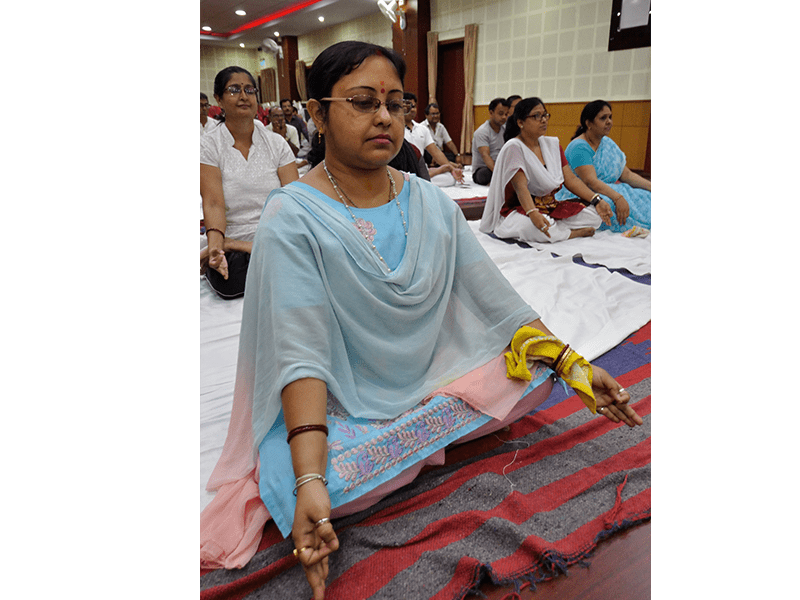Whether you are new to yoga or have been practising it for a while, you must be aware that mastering the pranayama or breath control exercises is an important part of developing your practice. One such powerful exercise that can help increase your inner awareness and rejuvenate your body and mind is kapalbhati pranayama.
What Is Kapalbhati?
The word kapalbhati is made up of two Sanskrit words, ‘kapala’ meaning skull or forehead and ‘bhati’ meaning illuminating or shining. This exercise is rather a ‘cleansing technique’ which effectively detoxifies the body. Regular practice of kapalbhati will bring a natural glow to your face.
From how to do kapalbhati pranayama to the various benefits of performing this kriya (technique), here’s everything you need to know.
11 Kapalbhati Pranayama Benefits That You Must Be Aware Of
Kapalbhati offers an array of mental, physical and spiritual benefits.
Here are a few kapalbhati pranayama benefits that will motivate you to include this breathing technique in your daily workout regime.
- The abdominal movement, which occurs as you inhale and exhale is great for the muscles around the stomach as well as that of the pancreas and liver. The pranayama increases the flow of blood to these areas.
- Since it stimulates the abdominal organs, kapalbhati is extremely beneficial for people with diabetes.
- It supposedly helps clear the nadis, which are subtle energy channels.
- One of the most significant kapalbhati pranayama benefits is that it helps cleanse the lungs, sinuses and respiratory system
- Kapalbhati aids digestion. It is useful in treating acidity and gas-related issues.
- Kapalbhati improves circulation and can help you achieve a radiant face.
- It can help you feel rejuvenated and more active.
- Kapalbhati increases the oxygen supply in the body. This, in turn, energises the nervous system and rejuvenates the brain cells.
- It can help uplift your mood and calm your mind.
- It helps increase the metabolic rate and aids in weight loss.
- Kapalbhati benefits for hair include the promotion of hair health and growth.
Step-By-Step Tutorial Of Kapalbhati Pranayama
Follow these kapalbhati steps carefully to perform the exercise accurately.
- Sit comfortably in a position where your spine is erect. Make sure your abdomen is not compressed. You may choose any one of these positions.
- Padmasana or Lotus position- sit crossed-legged and place each foot on the opposite thigh.
- Sukhasana or Easy Pose- sit in an upright position.
- Virasana or Hero pose- Sit on your heels with your knees bent. Your shins should be tucked beneath your thighs.
- Sit upright on a chair. Keep your feet flat on the floor.
- Keep your hands on your knees. Your palms should be open. Alternatively, you may place your hands on your lower belly (one on top of the other) in order to heighten your awareness.
- Take in a deep breath (through both the nostrils).
- Exhale with a (somewhat) forceful action. Force out the breath in a short burst. As you exhale, pull your stomach inward.
- Your inhalation should be automatic as you relax your abdomen and navel. Focus on exhaling.
- Repeat the kapalbhati steps and take around 20 such breaths to complete one round. Do at least 3 rounds.
- After every round, close your eyes and relax. Observe the sensations within your body.
- Gradually increase the number of breaths per round and the number of rounds per session.

9 Important Tips To Keep In Mind While Practising Kapalbhati Pranayama
- Kapalbhati pranayama is a rather advanced breathing technique. In case you are new Yoga breathing exercises, it is recommended that you take your time and master basic techniques like Ocean Breath (Ujjayi Pranayama) and Three-Part Breath (Dirga Pranayama). Once you are proficient with these exercises, move on to kapalbhati pranayama.
- Experts recommended practising kapalbhati pranayama early morning on an empty stomach. If that does not suit your daily schedule, you may do it around 3 hours after you have eaten.
- While performing kapalbhati, your focus should be on your exhalations and your lower belly.
- Make sure you don’t contact your abdomen while inhaling.
- Your spine and shoulders should remain still throughout the practice.
- The kriya should be followed by easier breathing practices like anulom-vilom.
- Continue the exercise at your own pace. Stop in case you feel dizzy.
- If you suffer from back issues, you may do the exercise while resting against a wall for support.
- If you suffer from lower back issues, asthma, hypertension, heart problems or high blood pressure, it is best to perform kapalbhati under supervision and expert’s guidance.
When Should You Avoid Practising Kapalbhati Pranayama?
There are a few exceptional cases where experts recommend it is best to avoid doing this breathing technique. These include:
- Those who have a stent or artificial pacemaker
- Those who have issues like hernia or epilepsy
- Those who suffer from slip discs
- People who have undergone abdominal surgery in the recent past
- Women who are pregnant or have just given birth
- Women who are menstruating. Avoid doing kapalbhati during periods
Performing kapalbhati pranayama does not require much effort but it gives wonderful returns. Other than being extremely beneficial for your health and mental well-being, it also offers spiritual paybacks. Regular practise of this kriya will activate the chakras in your body and help you achieve a higher level of awakening. Now that you know what is kapalbhati and how to do kapalbhati pranayama, you are ready to embark on your wellness journey.

